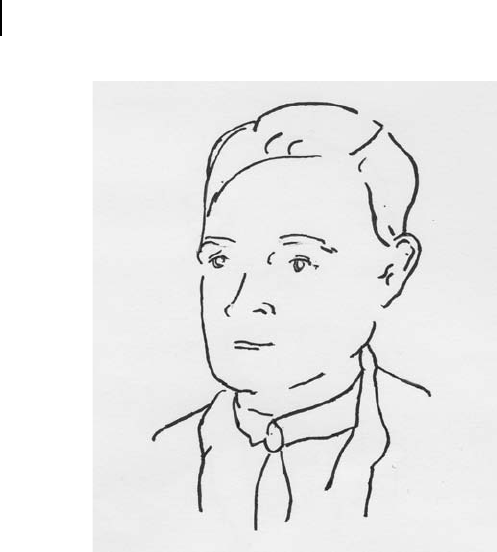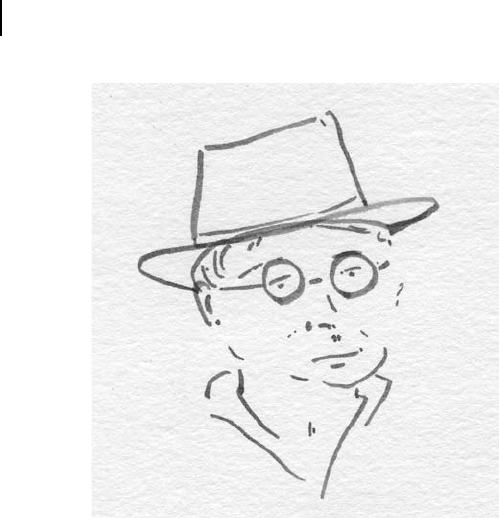June 25, 2012 12:25 PSP Book - 9in x 6in 04-Junichi-Takeno-c04
Chapter 4
Human Consciousness and the Mind
This chapter introduces historical research into the mystery of
thought, consciousness, and the human mind, and, in particular,
areas of mathematics, psychology, and philosophy. I believe an
intricate mechanism of consciousness and mind exists in the
background of human thought.
Hippocrates (460 BC–375 BC), an ancient Greek physician, was
the first scholar who believed that human thought occurred in the
brain (Bear, 2001). He said that the brain controlled the body. He
reportedly discovered this fact through his experience in treating
gladiators who suffered brain damage in ancient Rome.
4.1 Human Thought and the Turing Machine
Alan Turing (1912–1954) (Fig. 4.1) was the first person in history
who mathematically challenged the mystery of human thought. The
Turing machine he proposed in 1950 may be considered the origin
of thinking machines. Turing said, “What can be solved by humans
can be solved by a machine of a small capacity” (Turing, 1936). He
thought that human intelligence could be realized by machines.
Creation of a Conscious Robot: Mirror Image Cognition and Self-Awareness
Junichi Takeno
Copyright
c
2013 Pan Stanford Publishing Pte. Ltd.
ISBN 978-981-4364-49-2 (Hardcover), 978-981-4364-50-8 (eBook)
www.panstanford.com

June 25, 2012 12:25 PSP Book - 9in x 6in 04-Junichi-Takeno-c04
32 Human Consciousness and the Mind
Alan Turing
1912–1954
Figure 4.1. Alan Turing.
The Turing machine has a very simple construction. It consists
of a body, a tape, and an input/output device called head to read
and write symbols on the tape. The Turing machine heralded
the development of present-day computers. In fact, it has been
mathematically proven that all problems that can be solved with
present-day computers can be solved with a Turing machine.
It should be remembered, however, that to create computers of
today, we needed a stored-program system, which was developed
on the basis of the ideas of John von Neumann (1903–1957) and
program-specific high-level concepts such as algorithms and data
structures.
It is also known presently that there is a problem that a Turing
machine cannot solve. The problem is for a Turing machine to decide
June 25, 2012 12:25 PSP Book - 9in x 6in 04-Junichi-Takeno-c04
Language and Formal Logic 33
if it will finish running or will run forever. Any given problem is
solved when the Turing machine finishes running.
Turing’s attempt to create models of human thought paved the
way to the development of computers, on the one hand, and the
study of artificial intelligence, on the other.
4.2 Language and Formal Logic
We will start with a description of the study of formal logic before
discussing mathematical ways to model human thought. According
to formal logic, human thought arises from languages, and is an
inference in languages. Formal logic was the basis of the study of
languages and inference at that time. The development of modern
formal logic is credited to Gottlob Frege (1848–1925), (Frege, 1892)
and Bertrand Russell (1872–1970), (Russell, 1959). I believe that
their objective of research was to unravel the intelligent functions
of humans from the standpoint of formal logic. Their attempts,
however, deviated from and became irrelevant to human thought
and shifted to a pure pursuit of formal logic itself. They attempted
to develop a method to derive mathematical knowledge from basic
mathematical hypotheses using logic. Their efforts were in vain,
however, when in the 1930s, Czech-born Kurt G
¨
odel (1906–1978)
mathematically proved that such an attempt was impossible (Fig.
4.2). These are G
¨
odel’s famous incompleteness theorems (G
¨
odelsche
Unvollst
¨
andigkeitssatz). The theorems say that formal systems are
incomplete because they inherently include arithmetic equations
that are defined to be true by the system but that cannot be
proved by the basic assumptions of the system. These theorems
thus negated the clarity of mathematics. The meaning of these
mathematical theorems also applies to the relationships between
human thought and the computer as a representative of formal
systems. Namely, there are some arithmetic equations that human
thought believes to be true but that cannot be proved by computers.
Based on this recognition, Nagel and Newman (1958) held that
computers could never reach the level of human thought or the
human mind. In 1994, Roger Penrose asserted that human thought
could clarify mathematical truths better than computers (Penrose,

June 25, 2012 12:25 PSP Book - 9in x 6in 04-Junichi-Takeno-c04
34 Human Consciousness and the Mind
Kurt Gödel
1906–1978
Figure 4.2. Kurt G
¨
odel.
1994). According to Penrose, Fermat’s last theorem was successfully
proved by human thought, whereas if the Turing machine were used
to solve that problem, it would have required infinite computations
about whether or not the problem was solved to find the solution.
He concluded that human thought solved problems that Turing
machines could not solve, that is, that human thought involves non-
computational elements that computers lack (Penrose, 1989, 1994).
He referred to the quantum theory to explain the non-computational
elements, but there are not many supporters of his argument today.
4.3 Language and Chomsky
Noam Chomsky (1928– ) is a famous linguistic researcher who at-
tempts to explain the philosophical aspects of humanity through the
study of language. His arguments are introduced here. Chomsky’s
June 25, 2012 12:25 PSP Book - 9in x 6in 04-Junichi-Takeno-c04
Language and Chomsky 35
conclusions are based on the fact that humans speak languages and
exhibit intellectual functions by conversing with others. Importantly,
the study of artificial intelligence started with the study of language.
Chomsky thought that creating a machine that understands and
speaks natural languages was a viable means to understanding the
human mind scientifically. In his Theory of Generative Grammar,
Chomsky showed that certain basic rules exist in the languages
spoken by humans (Chomsky, 1957). This theory provided a
scientific means to analyze human languages and contributed to the
later development of the PASCAL and LISP computer programming
languages.
Chomsky’s theories have influenced many researchers. One of
his famous studies involved chimpanzees that learned a “language”
and were able to communicate with humans. Pictograms or signs
(similar to a sign language) were used because chimpanzees
do not speak human language; so a sort of surrogate language
was used. The experiments were successful to some extent. The
chimpanzees understood the surrogate language as well as the
feelings shown by the humans. The experimenters also felt that
the chimpanzees were willing to show their feelings to the humans
using the surrogate language. The grammar was simple, however,
and complex sentences were not used.
Chomsky’s linguistic theory could not answer the question of
why children can quickly learn a language as they grow up. This
question is called Plato’s problem. To find the solution to this
problem, linguists started to study how language was generated and
understood in the language areas of the human brain.
Austrian-born Ludwig Wittgenstein (1889–1951) was a famous
philosopher who attempted to clarify human consciousness by
analyzing the natural languages of humans (Wittgenstein, 1953). He
tried to account for human conscious activities using the Language
Game concept (Wittgenstein and Solipsism).
Jean Piaget (1896–1980), a Swiss developmentalist, was a
famous figure in the study of how the functions of cognition develop
in infants (Piaget, 1952).
As discussed in the previous chapter, it is very difficult to
research the brain functions of humans. Human rights must be
respected when treating the human brain. Furthermore, even
..................Content has been hidden....................
You can't read the all page of ebook, please click here login for view all page.
